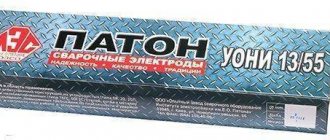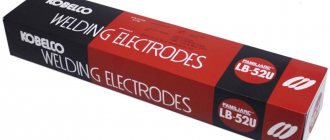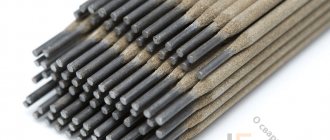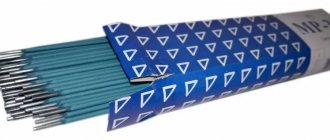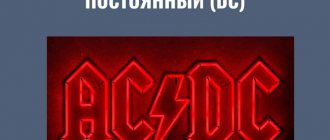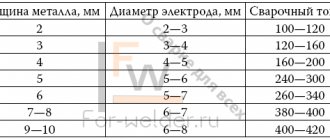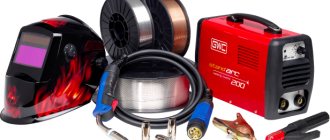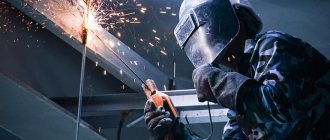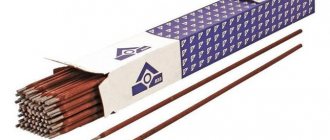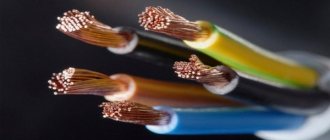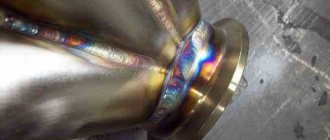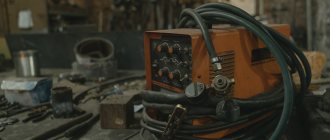What is an electrode: device
This is a rod made of metal or other electrically conductive composition. It ensures the supply of current from the device to the object that requires welding. The elements come in different lengths: from 25 to 45 cm. Each of them has a protective coating. It prevents the oxidation process. Only a small part of the consumable remains “bare” - the part that is inserted into the holder. Therefore, when searching for components, it is important to consider their thickness. Three-millimeter ones are considered the most popular. Options of 1 and 2 mm are less popular among specialists. Thin ones are used with steel sheets and other parts that require a jewelry approach. You can easily find five-millimeter elements in stores, but beginners rarely need them. Rods with an end larger than 3 mm are needed for alloys that form thick sheets. To work with them, you need a high-power device, which not every beginner has. The variety of choices makes you wonder how to choose the right welding electrodes for an inverter and select their diameter according to the thickness of the metal for high-quality welding. We recommend that you be guided by the following principle: compare the values on the components and the material you plan to deal with. For example, for 2mm metal sheets, use 2mm rods.
Selection criteria
Unfortunately, Russian electrodes are inferior to many foreign analogues in most parameters. However, “breakthroughs” in this area have already emerged. Russian electrode products, produced at the still few joint ventures, are no longer inferior to many venerable brands in terms of quality stability. Some factories of domestic subordination also began to “catch up” to them. However, in cases where it is necessary to confidently ensure high quality of the seam, professionals still prefer to use more expensive, but also higher quality, foreign-made electrodes. Electrodes of any type are suitable for welding inverters; not all types are suitable for AC welding machines.
When selecting the best electrodes for review, we were guided by the following criteria:
- production volumes;
- product quality;
- the manufacturer's inclusion in reviews of the electrode industry;
- reviews from professionals.
For a fair comparison of prices, we included in the review only the most commonly used electrodes with a diameter of 3 mm.
The main parameter of any welding electrode, which determines most of its properties - from ease of ignition to the quality of the seam - is the composition of its coating. The most common types of coatings today are:
- Rutile electrodes (and electrodes with a mixed coating on this basis - rutile-cellulose and so on) have become one of the most popular due to their ease of ignition, including re-ignition, and reduced (within reasonable limits) sensitivity to dampness. They can be used on both alternating and direct current in all directions of the seam, but when choosing a rutile electrode you need to be careful - you can buy both a good electrode and one that contaminates the seam with a huge number of slag pits, suitable only for tack welding.
- Basic coated electrodes are most often used for DC welding in critical areas. When the coating burns, carbon dioxide is released in large quantities, which reliably protects the weld pool from exposure to oxygen. The seam itself is more ductile than when welding with common types of rutile electrodes. The other side of the coin is increased sensitivity to humidity and difficult ignition: it is much more difficult to cook with such electrodes.
Classification of consumables
| by appointment | designation | |
| for carbon and alloy structural steels with a tensile strength of up to 600 MPa | e38, e42, e42a, e46, e46a, e50, e50a, e55, e60 | at |
| for alloyed structural metals with a tensile strength of more than 600 MPa | e70, e85, e100, e125, e150 | l |
| for heat-resistant materials that have undergone alloying | e09m, e09mkh, etc. | T |
| welding of high-alloy parts with special properties | e12x13, e06x13m, e10x17t, etc. | V |
| surfacing of surface coatings with special characteristics | e10g2, e11gz, e16g2khm, etc. | n |
Identifying common groups among a great variety of options is a difficult task, which not all experienced craftsmen undertake. They are schematically divided according to their purpose, the chemical composition of the fused alloy, types, thickness, material from which they are made, and mechanical properties. Experienced specialists use those consumables that they are used to, or those that satisfy them in terms of price and quality ratio. When choosing, they usually take into account two criteria:
- The type of metal you will need to work with. If welding work is carried out at home, then most often we are talking about iron and alloys based on it - the so-called ferrous ones. In this case, the only thing a beginner should consider is the carbon content. Find out what kind of steel you will be dealing with: high, medium, low carbon or cast iron. Acquaintance also often has to start with “stainless steel”.
- Design requirements. Before deciding which electrodes to choose for inverter welding and how, it is necessary to understand whether the seams will be subject to vibration loads or temperature changes. In this case, you should pay attention to rods with enhanced properties.
Foreign manufacturers
Answering the question “Which electrodes to choose for welding with an inverter?” It is worth mentioning foreign manufacturers. There are many brands on our market, but we will focus on European ones. In our opinion, Abicor Binzel, ESAB, Böhler Welding and ELGA are the best.
Whatever manufacturer you choose, their products can be used to carry out all types of welding work: welding carbon steel, pipe joints, performing particularly complex work with difficult-to-weld metal, welding cast iron, copper and aluminum. If you cook to order or perform work with an increased degree of responsibility, then choose foreign manufacturers. Their quality is many times higher than the products of Russian manufacturers, since there is strict control in production.
Classification by type of coating
There are 4 options:
Basic or calcium fluoride
Identified by the letter "B". It consists of calcium and magnesium carbonates. It may contain marble, magnesite, dolomite. These elements have a low oxidizing ability, due to which the process of removing oxygen from the molten metal is faster. The second name appeared due to the fact that the slag diluent is natural calcium fluoride - fluorite. The advantage of calcium fluoride electrodes is their low hydrogen content. This factor allows you to obtain a strong seam, without gases and impurities, and also minimize the risk of hot cracks. Consumables with a main protective layer are ideal for pipelines carrying hydrogen sulfide compounds, as they resist cracking well. But there is also a nuance. Everything must take place with a direct current of reverse polarity, since calcium fluoride inhibits the operation of components with alternating voltage and the welding arc may burn unstably. Choose electrodes with this type of coating if you plan to work with steel with a high sulfur content or a material that must withstand heavy loads or will be regularly exposed to high temperatures. They are also suitable for welding rigid structures.
Rutile
Despite the fact that a different type is called “main”, this is the option used in 95% of works. The gas released during combustion is non-toxic, so this is the safest solution for the health of the master. The metal seam made with the concentrate is resistant to cracks, does not bend or break, since the consumable material increases viscosity. This coating is ideal if the welder works with a short seam, because the arc burns well even if the voltage in the network fluctuates. For people who have not yet developed their hand and cannot hold it throughout the entire work process, this is the best option. In addition, you can operate with it in any spatial plane.
Sour
Suitable if welding work needs to be accelerated by forcing or lengthening the arc discharge. This is the most toxic type. Due to the increased level of splashing, it can only be interacted with in the lower position. It should not be used for high-temperature calcination. Not recommended for beginners.
With cellulose coating
Half consists of organic compounds - flour, starch, cellulose, half of natural and synthetic silicates. These are very thin consumables, so they can be used in any plane. With their help, a seam is created very easily, which increases the speed of completing the task several times, but the surface of the seam is uneven and requires grinding. Choose cellulose coating if you have to work with carbon and low-alloy steels. It is also suitable for hard-to-reach structures, since the diameter of such elements is minimal.
| type (designation in marking) | stamps |
| main (b) | uoni-13/45, uoni-13/45a, uoni-13/45, uoni-13/45a, uoni-13/45r, tmu-46, uoni-13/55, uoni-13/55k, uoni-13/ 55s, uoni-13/55u, uoni-13/55r, uoni-13/65, ozs-22r, 55-u, fno-t, fno-tm, fno-tm/n, its-4, its-4s, OZS-18, etc. |
| sour(s) | omm-5, cm-5, mez-4, etc. |
| rutile (r) | ano-21, ano-21m, ano-36, ozs-4, ozs-12, ozs-30, ozs-32, etc. |
| cellulose (c) | vsts-4, vsts-4m, oma-2, vsts-4a, etc. |
| mixed: carbonate-rutile (rb) | ozs-28, ano-3, ano-4, etc. |
| rutile-carbonate-fluoride | ozl-9a, etc. |
| ilmenite | ozs-41, mr-3u, mr-3r, etc. |
| rutile-cellulose (rc) | ano-13, fno-29m, etc. |
| acid-rutile (ar) | ano-6, ano-6m, ano-17, ozs-23, ano-24, etc. |
| rutile-ilmenite | mr-3m, etc. |
| with iron powder (g): rutile with powder filler (rzh) | ozs-6, ano-1, ano-27, uoni-13/55tzh, etc. |
| other (n) | for cast iron, non-ferrous alloys, salt. |
The best rutile coated welding electrodes
Such rods are used when processing low-carbon and low-alloy steels. The resulting seams are not prone to pore formation and are resistant to hot cracks.
Electrodes with rutile coating have a low metal spatter coefficient, ensure ease of ignition and stable arc burning.
Resanta MP-3
4.9
★★★★★
editorial assessment
93%
buyers recommend this product
See review▶
The main feature of Resant electrodes is the complete absence of cracks after solidification in the metal. The uniformity of the joint prevents the penetration of moisture and ensures high strength of the seam.
The diameter of the rod is 3 mm; it is used to weld material 3-4 mm thick. When using such an electrode, it will be possible to obtain a high-quality seam even on wet, corroded or primed metal.
Advantages:
- minimal splashing;
- ease of re-ignition;
- working with wet surfaces;
- seam strength.
Flaws:
- volumetric slag releases.
Resanta MP-3 is used for welding in conditions of negative temperatures or high humidity.
The resulting seam is resistant to static and shock loads, which will be very useful in the manufacture of large tanks or ship hulls.
Wester MP-3
4.8
★★★★★
editorial assessment
90%
buyers recommend this product
The main features of Wester electrodes include a thin coating and ease of arc re-ignition. This ensures efficient processing of thin sheet metal when frequent stops or long breaks are required.
The electrode diameter is 3 mm, the consumption per 1 kg of deposited metal is 1.7 kilograms. Due to the permissible moisture content in the processed material of 1.5%, such rods can be used to weld moistened and oxidized surfaces.
Advantages:
- easy removal of slag;
- neat seam;
- ease of re-ignition;
- minimal metal spattering.
Flaws:
- requires long-term calcination.
Wester MP-3 are used for manual arc welding of low-carbon steels. They can be used to treat rusty or dirty surfaces.
Quattro Elementi 770-414
4.8
★★★★★
editorial assessment
88%
buyers recommend this product
The electrodes are characterized by a powerful and stable welding arc thanks to the use of a tungsten rod. Their use when processing metal covered with scale or rust prevents the formation of pores and microcracks in the seams.
Element diameter is 2 mm, processing temperature is 170-190°C. High-quality coating and refractory rod guarantee minimal metal loss during operation and resistance to low welding current.
Advantages:
- strong seam;
- smoothness of the connection;
- stable arc burning;
- easy ignition.
Flaws:
- fast consumption.
Quattro Elementi 770-414 are designed for processing thin sheet metal. A good choice for household welding or body repair.
SVEL MR-3C
4.8
★★★★★
editorial assessment
86%
buyers recommend this product
These rods are distinguished by their welding efficiency on short and medium welding arcs. They are recommended for heavy-duty use due to their combustion stability and operation with both direct and alternating current.
The diameter of the rod is 3 mm, which makes it possible to weld metals with a thickness of about 4 mm. Surface treatment is carried out in almost any spatial position.
Advantages:
- deep penetration;
- work in any position;
- low price;
- economical consumption.
Flaws:
- slag splashing.
SVEL MP-3C is worth purchasing for welding in hard-to-reach places or in awkward positions. Electrodes are used when processing critical structures, the inner sides of tanks or wide pipes.
How to choose electrodes for welding with an inverter
Metal diameter and thickness
Compare these two criteria. They should be approximately the same. For inverter equipment, rods up to 2 mm are usually taken, because they are not suitable for larger orders.
Purpose
There are many subtleties. The choice depends on the work technology you will use, welding equipment, and source material. Universal advice - don’t chase cheap offers. Of course, a master can perform a task efficiently using any means at hand, but you should pay attention to mid-price options that minimize mistakes and won’t break your pocket.
Popular and best domestic electrodes for welding
ATTENTION! The following information is based on publicly available data at the time of this writing. For greater objectivity, we will make our own rating of welding electrodes, which is given below. We invite you to add your voice.
As a result of marketing research of the welding materials market, the most popular brands in recent years are:
- Resanta.
- SpetsElektrod (Moscow).
- “LEZ”.
The expert rating is as follows:
- KOMZ.
- ESAB-Tyumen.
- “Penzaelectrode”.
- “LEZ”.
- "SEZ".
[ads-pc-4][ads-mob-4]
Which electrodes are best for cooking: choose by type of metal products
Fence
Consumables with rutile coating are a win-win for a beginner. This is AHO with numbers 4,6, 21, 36., MP-3, OK-4600. You can also take rods of mixed recipes “Monolith”, “Granite”, “Arsenal”. The advantage is easy initiation of the electric arc. You will be able to weld with a tear, and pores will not form in the seam. Effective when you need to quickly erect a multi-meter structure.
Thin metal
To avoid burning holes, look for elements with a minimum diameter: we have already discussed how to choose the right electrode for welding above - correlate it with the thickness of the sheet.
Pipes
Gas is treated with grades OK-46 and LB-52. For the heating system, purchase E42A, UONI-13/45, for water supply - MN-5 and MNZh5.
Channel
It all depends on the size of the part. If they are small, then he chooses five or six millimeter ANO-21. You can even cook rusty surfaces with them. If the dimensions of the channel are impressive, only UONI-13/55U. They do not limit the master: alternating and direct current, reverse and direct polarity.
Rails
Experts recommend brands UONI-13/45 and UONI-13/55.
Which electrodes for an inverter are better when welding with a Resanta machine?
Welding electrodes for Resanta must be selected in the same way as for other devices, namely, paying attention to the part itself. Answering the question of which electrodes are best for inverter welding with Resanta, we advise increasing the electrode diameter and current strength depending on the thickness of the part.
For example, with a part thickness of 10 mm, it is preferable to use a rod with a diameter of 5 mm. The Resanta company produces electrodes itself; they have a diameter from 2.5 to 5 mm. But they have one drawback - reduced plasticity.
Choosing electrodes for welding with an inverter for beginners: how and which ones to choose by type of metal
Very often, at home, the main criterion that guides a novice welder is the material.
Stainless steel
This is one of the most frequently used components, so consumables for it are even included in a separate group. For manual use, take the TsL-11 - it is a reliable and easy-to-use option.
Cast iron
It also has its own group of consumables. They are nickel, copper and iron-copper-nickel. Give preference to the OZCH brand. For a malleable alloy, product numbers 2 and 6 are suitable, for a cast alloy – 1 and 3.
Armature
Products with rutile or basic coating ANO-21 are suitable for this.
Galvanization
Popular products made from this material are UONI 13/55, TsU-5, TsL-20, TMU-21.
Copper
Special consumables for ductile metal – OZB-2M and ANTs/OZM-2.
Purpose
In addition to brand and diameter, they are divided according to their purpose. This also determines which electrodes are best for the inverter. Conventionally, they are divided into the following electrodes:
- For welding carbon or low alloy metals.
- For welding parts made of durable heat-resistant metals.
- For working with stainless steel.
- For working with aluminum and copper alloys or directly aluminum and copper.
- For welding cast iron parts.
- For minor repairs and surfacing.
- Universal-purpose electrodes used for welding parts made of unknown metal.
How to choose the best electrodes for inverter welding
Experienced professionals recommend the following brands:
Calcium fluoride coating
- ESAB;
- SSSI 13/55.
Rutile layer
- AHO-4;
- MP-3;
- OK 46.00.
Stainless steel
- NZh-13;
- OZL-8;
- TsL-11.
We told you how a novice master can choose suitable consumables, gave instructions on which options to choose if you cannot yet assess the situation from the height of your own experience, and told you how to choose a certain electrode diameter. We hope our recommendations will allow you to do the job efficiently and help you further improve your skills. is engaged in the sale of bandsaw machines; for individual consultation, please contact our managers at the contact numbers listed on the page.
The best brands of rutile electrodes
It goes without saying that rutile electrodes also have popular and sought-after brands, which over the years have generated only positive reviews. First of all, these are MP-3 and OK-46 electrodes. These electrodes are distinguished by their versatility and ease of use.
Separately, it is worth noting the ANO-4 electrodes, which also have a rutile coating. This is a very popular brand of electrodes that are in great demand both among welding masters and novice welders. Particularly popular is the ANO-4 “Arsenal” brand of electrodes, which cook equally well in both mud and water.
But it’s definitely not worth starting to master welding with UONI electrodes, despite their highest quality and impeccable weld seam. The thing is that UONI welding electrodes are very capricious and demanding to work with. To weld properly with these electrodes, you need at least a little experience in electric welding.
Share your experience too! What electrodes did you start cooking with? Well, due to my ignorance at that time, I started cooking with Monolith electrodes.
Share on social networks
Advantages of modern electrodes for inverters
The quality of welding largely depends on which electrodes are best for welding with an inverter. Modern products have noticeably improved and acquired many positive qualities:
- Welding has become much easier. Difficulties during work arise extremely rarely, mainly due to the wrong choice of core material.
- Ability to form high-quality seams. They are excellent for internal and external connections and can have a convex or concave shape.
- The slag formed during welding with modern electrodes is very easily removed from the surface and allows you to immediately control the quality of the seams.
- The ability to weld workpieces covered with rust and obtain, despite the corrosion, a high-quality weld.
- Almost all types of electrodes are safe for the health of the welder.
In more detail, the main electrodes for welding with an inverter and which of them are best can be considered on specific brands that are best known and most often used for welding work.
Features of choosing electrodes
When choosing consumables, it is important to correctly evaluate which ones best suit your needs. From the variety available for sale, suitable products are determined based on criteria such as type of coating and diameter. The latter should not be more than necessary - this will reduce the current density, worsen the penetration of the elements and make the formation of the welding arc unstable. The width of the seams increases, which reduces their strength.
Diameter and dimensions
When selecting consumables for welding, it is necessary to determine the correct diameter.
It depends on the thickness of the elements being connected:
- For parts with a thickness of 2 mm, you can choose electrodes with a diameter of 2.5 mm.
- For 3 mm products – 2.5 mm electrodes.
- For a thickness of 4-5 mm - diameter 3.2-4 mm.
- For parts 6-12 mm - rods 4-5 mm.
- For a thickness of 13 mm, the diameter of the consumables should be 5 mm.
In addition to the thickness of the rods, the welding process is influenced by the correctly selected power of the equipment.
Purpose of the electrode
Before choosing electrodes, determine the appropriate purpose for you. There are different brands of consumables for different metals.
The type of alloy suitable for welding is determined by the letter in the product label:
- U - used for welding low-alloy carbon steels.
- M – for alloyed material.
- T – for obtaining strong connections when working with alloy steels with increased heat resistance.
- N – for welding metal in the area of the upper layers.
- B – suitable for working with products made from high-alloy raw materials for special purposes.
We recommend reading How an inverter welding machine works
Understanding the markings, it is easy to choose the appropriate type of product to ensure good welding quality.
External covering
Manufacturers apply special mixtures to them to improve the performance properties of electrodes.
Rod coatings are divided into the following categories:
- Ferrosilicon, ferromanganese (marked with the letter A). Its use increases the fusibility of the core, which has a positive effect when welding lower seams.
- Rutile (marked as P), is a layer of titanium dioxide with liquid glass. When it is used, the formation of slag increases and the evaporation of alloying components decreases. The seams have high strength and tear resistance.
- C – cellulose material with the addition of manganese, talc and cellulose. The advantage of the material is the ability to form a protective gas cloud in the area of the weld pool. This helps make the connection better. Such electrodes are often used to work with rolled pipes.
- The calcium carbonate base coating (B) also contributes to the formation of protective gas. But the material is not suitable for creating a permanent seam; modifications need to be made.
Other coating options are designated by the letter P. They include alloying components that increase the strength of the joints.
Which welding electrodes are best for aluminum?
Aluminum (how to weld with electrodes), due to its own advantages, is actively used in the production of products for various purposes. To perform welding at a high level, you need to pay attention to the characteristics of the metal. These specific features affect the workflow:
- the surface of parts made of aluminum and its alloys is covered with an oxide film , which has a higher melting point and greater density than the metal itself;
- the formation of a seam is hampered by the high fluidity of aluminum ;
- hydrogen, which is part of aluminum, negatively affects ductility and strength;
- Due to the high thermal conductivity of the alloy, it is recommended to carry out the connection using powerful heat sources.
Overview of electrodes designed to work with aluminum:
OZANA-1 are suitable for welding and surfacing of parts made of pure aluminum; The seam is highly corrosion resistant.
UANA are used for welding, surfacing and defect welding of aluminum alloys.
KOBATEK-213 materials are suitable for working with both aluminum and its alloys.
Adjusting the welding current
The welding current used in the Resanta inverter is set in accordance with the diameter of the electrode. This information is given in the table; it is also indicated on the product packaging. The simplest calculation assumes for each millimeter in diameter from 20 to 30 A of welding current. Despite such a wide range, good results are obtained that are acceptable for work. In addition, you need to consider how the seam will be applied. If welding is performed without separation, low currents should be used, and with separation, increased current will be required.
What electrodes are needed for cutting metal
Cutting is a technological process whose purpose is to separate metals into workpieces of the required shape and size.
Types of electrodes intended for cutting:
OZR and ROTEX R electrodes are intended for cutting, gouging and piercing holes, removing defective areas, cutting edges and weld roots. In addition, these brands are used in the manufacture, repair and installation of various structures from different metals and alloys.
Classification of electrodes
Electrodes for welding with an inverter are available as consumable or non-consumable. Products of the first category are rods with a metal base, the surface of which is coated with special compounds.
Such mixtures provide protection for the welding zone and increase arc resistance. When the composition melts, a weld pool is created and the seam is filled with liquid metal.
Subclasses:
- Electrodes can be produced with a coating that stabilizes the electric arc. Their use improves the performance properties of welds.
- Elements without an additional layer. They are not used for manual arc welding.
We recommend reading Welding inverter Resanta SAI-250
Consumable types of electrodes can be used for manual arc welding.
Non-consumable types are suitable for gas-shielded welding. They can be made of graphite, compressed carbon, tungsten. The products act as anodes, cathodes, and contribute to the formation of an electric arc. The material for forming the seam is formed using filler wire.
Tungsten types are more suitable for working in an argon environment, but their price is higher.
Products can be divided according to the type of coating that is applied to metal rods, according to size and purpose. To choose the right option for reliable connection of the surfaces to be welded, you need to familiarize yourself with their characteristics.
